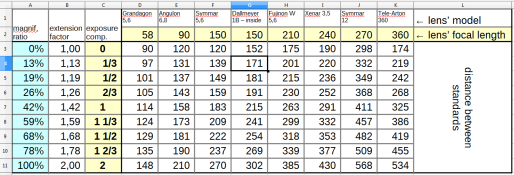pbromaghin
Subscriber
I have been reading Stroebel's View Camera Technique, a tough but rewarding slog. There's a lot of math (mostly geometry) but it explains in great depth just how cameras and lenses work. On page 184 there are a couple of equations for calculating bellows extension exposure compensation. I think I know what is going on in them, but am not 100% sure.
1) Effective fN = Marked fN X (Image-Distance/Focal Length) = fN X v/f
Question 1: Does the Focal Length (f) in the divisor equal the infinity focal length of the lens (which is always the same for a particular lens), or is it the measured length when focused on the image? Infinity focal length seems to make the most sense.
Question 2: Is the "Marked fN" the current aperture setting of the lens? Again, this seems to make the most sense.
2) Exposure Factor = (Image Distance)2 / (Focal Length) 2
Question 3: Just what does one multiply against the resulting "Exposure Factor"?
In my fiddling with the numbers, if I have been doing it right, it does appear that multiplying the Effective f-stop by the Exposure Factor does yield the Marked f-stop.
1) Effective fN = Marked fN X (Image-Distance/Focal Length) = fN X v/f
Question 1: Does the Focal Length (f) in the divisor equal the infinity focal length of the lens (which is always the same for a particular lens), or is it the measured length when focused on the image? Infinity focal length seems to make the most sense.
Question 2: Is the "Marked fN" the current aperture setting of the lens? Again, this seems to make the most sense.
2) Exposure Factor = (Image Distance)2 / (Focal Length) 2
Question 3: Just what does one multiply against the resulting "Exposure Factor"?
In my fiddling with the numbers, if I have been doing it right, it does appear that multiplying the Effective f-stop by the Exposure Factor does yield the Marked f-stop.












